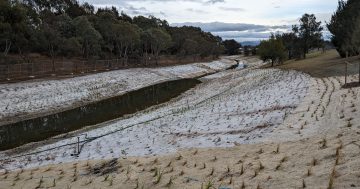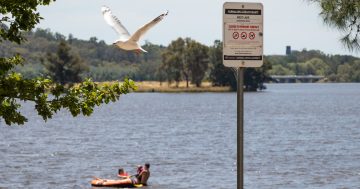
Healthy Waterways Program Manager Ralph Ogden, Minister for Water Shane Rattenbury, holding a section of the floating wetland, and local MLA Johnathan Davis stand in front of the artificial islands. Photo: Supplied.
What appears to be floating rectangular islands in a section of Lake Tuggeranong may turn out to be a solution to the water body’s notorious blue-green algae problem that strikes during the warmer months.
The artificial wetland placed strategically at an inlet that has been identified as an algae producing hot spot is designed to suppress blooms by competing with algae for light and nutrients.
Successful in other locations in Australia and overseas, the wetland is part of a two-year trial being conducted by ACT Healthy Waterways with funding from the ACT Government.
Minister for Water Shane Rattenbury said the trial was the first large-scale deployment of a floating wetland within the ACT.
“Ongoing research shows that the introduction of a new wetland environment in Lake Tuggeranong will create competition with algae for nutrients and light, making it much harder for algal blooms to spread,” Mr Rattenbury said.
The wetland which is secured to the shore, will cover about 500 square metres and is made of a fibrous recycled, UV resistant plastic base covered with a mat of coconut fibre.
The plants, fungi and bacteria that grow on their roots will take up nutrients from the water helping to improve water quality.
“The algal blooms are detracting from the use of Lake Tuggeranong because they can be hazardous to both humans, dogs and other animals, so we need to ensure the lake is in as good a condition as we can make it to make the most of it,” Mr Rattenbury said.

The floating wetland in Tuggeranong. Photo: Supplied.
Healthy Waterways Program Manager Ralph Ogden said the wetland could be one of a number of strategies to control algal bloom on the lake.
“We’re going to have to try a number of things – there is not going to be any single solution,” he said.
“It’s going to take several years and a bunch of different approaches.”
Mr Ogden said organic matter caught in nearby pollutant trap stewed in the summer spawning algal blooms.
“When the flows are really low and the temperatures are really hot, that’s a perfect environment for algae to bloom and get washed into the lake,” he said.
Mr Ogden said a range of wetland plants would cover the islands in about a year and be quite a feature on the lake.
“We’re interested to see how it performs and whether it’s suited to this kind of climate,” he said.
Mr Rattenbury said the government was prioritising initiatives that will reduce the flow of nutrient pollutants into the ACT’s lakes when it rains to preserve and improve their water quality.
“If the trial is successful, the wetland will be maintained in Lake Tuggeranong on an ongoing basis,” he said.
The wetland platforms are manufactured in the United States with plants provided locally with input from the Woodlands and Wetlands Trust and Ginninderra Catchment Group.



















